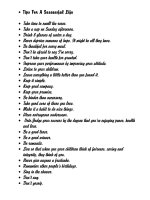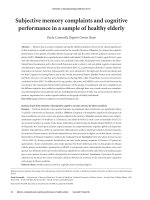Glutenfree for a Healthy Life pot
Bạn đang xem bản rút gọn của tài liệu. Xem và tải ngay bản đầy đủ của tài liệu tại đây (1.53 MB, 193 trang )
This comprehensive resource describes every aspect of celiac
disease including diagnosis and daily survival skills. There is an
entire chapter which contains invaluable advice from those with
the most experience—people with celiac disease!
—Trisha B. Lyons, RD, LD
MetroHealth Medical Center,
Cleveland, OH
A clear and comprehensive guide for anyone newly diagnosed
with celiac disease, complete with valuable resources.
—Glutenfreeda.com, Inc.
(Jessica Hale and Yvonne Gifford,
Editors)
An excellent resource for those dealing with celiac disease and
also for those who care for people with the disease. An
invaluable tool with loads of resources and useful information
presented in a concise, easy-to-understand manner!
—Marla Doersch, RD
A wonderfully comprehensive and invaluable guide to celiac
disease, complete with the collective wisdom of the celiac
community.
—Bonnie J. Kruszka,
Author of Eating Gluten-Free with Emily
This book will be a useful resource for those on gluten-free
diets.
—Carol Fenster, Ph.D.,
Author of Gluten-Free 101
Kimberly Tessmer, RD, LD, has authoritatively compiled a
wealth of useful information on the most life-altering aspect of
celiac disease: its treatment. The highly practical and detailed
information contained in this book will help both the celiac
patient/parent and their healthcare providers minimize the
bewilderment associated with following a gluten-free diet in
today’s fast-paced, fast-food, highly processed world.
—Kenneth Fine, M.D.
Founder and Director of EneroLab.com
Clinical Laboratory and the Intestinal
Health Institute, Dallas, Texas
This book is full of practical and helpful information on gluten-
free living along with valuable tips and recipes from the experts
themselves: those with celiac disease. This book would be a
welcome addition to the celiac bookshelf!
—Shelley Case, B.Sc., RD
Author of Gluten-Free Diet: A
Comprehensive Resource Guide
Gluten-Free for a Healthy Life covers the territory for those
looking for information on celiac disease and the gluten-free
diet.
—Ann Whelan
Editor of Gluten Free Living
Gluten-
free
for a
Healthy
Life
NUTRITIONAL ADVICE AND RECIPES FOR
THOSE SUFFERING FROM CELIAC DISEASE
AND
OTHER GLUTEN-RELATED DISORDERS
Kimberly A. Tessmer, RD, LD
NEW PAGE BOOKS
A division of The Career Press, Inc.
Franklin Lakes, NJ
Copyright @ 2003 by Kimberly A. Tessmer, RD, LD
All rights reserved under the Pan-American and International Copyright
Conventions. This book may not be reproduced, in whole or in part, in any
form or by any means electronic or mechanical, including photocopying,
recording, or by any information storage and retrieval system now known
or hereafter invented, without written permission from the publisher, The
Career Press.
G
LUTEN-FREE FOR A HEALTHY LIFE
EDITED BY KATE HENCHES
TYPESET BY EILEEN DOW MUNSON
Cover design by Dorothy Wachtenheim
Printed in the U.S.A. by Book-mart Press
To order this title, please call toll-free 1-800-CAREER-1 (NJ and Canada:
201-848-0310) to order using VISA or MasterCard, or for further
information on books from Career Press.
The Career Press, Inc., 3 Tice Road, PO Box 687,
Franklin Lakes, NJ 07417
www.careerpress.com
www.newpagebooks.com
Library of Congress Cataloging-in-Publication Data
Tessmer, Kimberly A.
Gluten-free for a healthy life : nutritional advice and recipes for those suffering
from celiac disease and other gluten-related disorders / by Kimberly A. Tessmer.
p. cm.
Includes index.
ISBN 1-56414-688-X (pbk.)
1. Gluten-free diet. 2. Gluten-free diet—Recipes. I. Title.
RM237.86.T47 2003
641.5’638—dc21
2003044571
Disclaimer
At the time this book was written all information in this
book was believed by the author to be correct and factual. In-
formation on celiac disease and gluten-free food changes fre-
quently as more research is being completed. Always keep
yourself up-to-date by reading current publications and con-
tinue to check food ingredient lists. The author shall have no
liability of any kind for damages of any nature however caused.
The author will not accept any responsibility for any omissions,
misinterpretations, or misstatements that may exist within this
book. The author does not endorse any product or company
listed in this book. The author is not engaged in rendering medi-
cal services and this book should not be construed as medical
advice, nor should it take the place of regular scheduled ap-
pointments with your physician and/or dietitian. Please, con-
sult your healthcare professional for medical advice.
This page intentionally left blank
To my Mom and Dad,
Don and Nancy Bradford,
who were role models teaching me that
anything is possible.
They passed on to me their knack for helping others
and have shown me, in the past few months, how
important it is to be there for people
and to take care of each other.
Thank you for all the love and encouragement you
have shown me throughout my life.
To my husband, Greg Tessmer, and my entire
family for their constant love, support, and
encouragement.
I would like to sincerely thank—
all of the people who helped me in so many ways to
write this book. A very grateful thank you to all of the
people with celiac disease who shared their time, ideas,
tips, stories, and recipes with the hope of helping others.
Trisha Lyons, RD, LD, and Regina Celano: A very special
thank you to both of you for all of your time and input into this
book. Thank you for showing me the resilient, passionate, and
caring spirit that people with celiac disease possess!
Many thanks also to: Shelley Case, B. Sc., RD, author of
Gluten-Free Diet: A Comprehensive Resource Guide; Ann
Whelan, editor of Gluten Free Living; Carol Fenster, Ph.D.,
Savory Palate, Inc., author of Gluten-Free 101: Easy, Basic
Dishes without Wheat; Yvonne Gifford, Editor & Chef of
Glutenfreeda online cooking magazine; Jessica Hale, Editor &
Chef of Glutenfeeda online cooking magazine; Kenneth Fine,
M.D. of EnteroLab; Marla Doersch, RD; Bonnie Kruszka, au-
thor of Eating Gluten-free with Emily; Connie Sarros, author of
Wheat-free Gluten-free Cookbook for Kids and Busy Adults; Bette
Hagman, author of The Gluten-Free Gourmet Cooks Fast and
Healthy; Christine A. Krahling, Communications Consultant;
Lindsay Amadeo; Marcy Thorner of The Grammer Guru.
#asdfghjkl;%[p[%asdfghjkl;Q4
s
d
A
E
Y
T
Table of Contents
Introduction: A Look Inside Gluten-free for a Healthy Life 13
Chapter 1. Summing Up Celiac Disease 15
Who Needs to Follow a Gluten-free Diet? 15
Prevalence of Celiac Disease 17
What Are the Symptoms of Celiac Disease? 18
How Is Celiac Disease Diagnosed? 20
How Is Celiac Disease Treated? 22
A Nutritional, Gluten-free Diet 24
Are There Complications of Celiac Disease? 26
What Other Diseases/Disorders Are Linked With
Celiac Disease? 27
Autism and Dietary Intervention 28
Communicating With Your Physician 29
Living With Celiac Disease 31
Chapter 2. All About Gluten-free Diets 33
What Is Gluten? 33
Getting Your Gluten-free Diet Started 34
What to Ask Manufacturers 37
Inspecting the Food Label 38
Which Foods Are Allowed, Not Allowed,
and Questionable? 44
Non-Food Gluten Products 50
Chapter 3. Children and Celiac Disease 51
Symptoms in Children 51
Diagnosis of the Child 52
Treatment of the Child 53
Challenges of a Child’s Gluten-free Diet 53
Pre-School Children 54
Attending School 55
The Teenage Years 58
Helpful Hints for Children of All Ages 59
Meal Ideas for Children 61
Resources for Children 63
Chapter 4. The Gluten-free Kitchen 65
Stocking Your Kitchen Cupboard 65
All About Gluten-free Flours 67
Tips for the Gluten-free Baker and Cook 73
Choosing a Bread Machine 76
Preventing Cross Contamination 78
Chapter 5. Preparing Everyday Gluten-free Meals 81
Planning Ahead 81
Start Your Day out Right: Breakfast Ideas 84
Time for a Lunch Break: Lunch Ideas 84
Super Suppers: Dinner Ideas 85
Got the Munchies?: Snack Ideas 87
Favorite Meals From the Experts 88
Chapter 6. Delightful Gluten-free Recipes 95
Wake up Your Taste Buds: Breakfast Recipes 95
Delicious Dining: Lunch and Dinner Recipes 97
Lighten It up: Soups and Salads 108
Jazz It up: Sauces 110
Be the Life of the Party: Appetizers and Party Foods 111
Everyone’s Favorites: Desserts and Breads 113
Chapter 7. Gluten-free for All Occasions 125
Special Occasion Challenges 125
Party On 125
Traveling Tips 126
Dining Out 128
Restaurants to Visit 132
Chapter 8. Tips From the Experts Themselves! 139
Helpful Hints for Living Every Day With a
Gluten-free Diet 139
Chapter 9. Resource Guide 155
Valuable Websites 155
Cookbooks 156
Cooking Schools/Clubs 158
Books 159
Associations/Groups 160
Dietitians Specializing in Gluten-free Diets 161
Support Groups 165
Message Boards/List Servs 165
Newsletters/Publications 165
Travel 166
Gluten-free Food Companies/Distributors 167
Chapter 10. Don’t Be Afraid to Ask! 173
Frequently Asked Questions and Answers 173
Index 185
About the Author 191
13
#asdfghjkl;%[p[%asdfghjkl;Q4
s
d
A
E
Y
T
Introduction:
A Look Inside Gluten-
free for a Healthy Life
Celiac disease has many names, such as gluten intolerance,
gluten-sensitive enteropathy, and non-tropical sprue. Each
name depicts a life-long autoimmune disorder in which a
person’s body cannot tolerate a group of grain proteins known
as gluten. These grains consist of wheat, rye, barley, and any
derivatives of these grains. Oats were always part if this list, but
recent studies have shown that a moderate consumption of oats
is safe for healthy children and adults who are well-established
on a gluten-free diet. However, further studies are needed to
determine long-term safety and contamination issues; there-
fore oats are not yet recommended by celiac organizations in
the United States and Canada. Celiac disease was once thought
to be rare, but is slowly being recognized as one of the most
prevalent genetic disorders in the United States.
The only definite treatment for celiac disease is strict ad-
herence to a 100-percent gluten-free diet for life. Learning and
following a gluten-free diet are not easy tasks but can help pre-
vent complications and symptoms that are associated with this
disease. People with celiac disease need help in getting started
in managing their diets and their lives and, through this book, I
hope to provide enough practical information to do just that.
Gluten-free for a Healthy Life
14
The good news is that people with celiac disease are not alone.
There are all types of groups that provide resources and sup-
port for people with celiac disease and for their families. As
the recognition of this disease grows, so does the pool of re-
sources. There are more choices today than ever before for
people with celiac disease.
This book serves many purposes. It will help people who
have been clinically diagnosed understand what celiac disease
is and the complex diet therapy that treats it. It is meant to help
those who have the disease (and their families) learn how to
manage their diet to lead a more comfortable, normal, and
healthy life. Physicians, nurses, dietitians, chefs, food service
staff, and other healthcare professionals may also find this
source useful as they come in contact with people who suffer
from celiac disease. This book also contains stories, tips, ideas,
and recipes from people who have celiac disease. My hope is
that people with celiac disease will feel more connected,
touched, and inspired by others who share in their difficulty.
This book should not substitute a visit to a physician and/or
dietitian who specializes in celiac disease and gluten-free diets.
It should also not be used as your solitary means of treating
your disease. Instead, the book should be used as a comple-
ment to their instruction and as a reference when needed.
15
#asdfghjkl;%[p[%asdfghjkl;Q4
s
d
A
E
Y
T
1
Summing Up
Celiac Disease
Who Needs to Follow a Gluten-free Diet?
Celiac disease is one of the most prevalent reasons for a
person to follow a gluten-free diet. Celiac disease is an autoim-
mune inflammatory disorder of the small intestine that is also
known as gluten-sensitive enteropathy or non-tropical sprue.
This disease can affect both children and adults. Its exact cause
is unknown though recent research suggests that genetics is a
strong component. Researchers believe that there are several
genes that work together to cause celiac disease as opposed to
a single missing or altered gene. Because our immune system is
partly controlled by heredity, it goes without saying that celiac
disease has a strong chance of running in the family.
For people with celiac disease, eating any food that con-
tains gluten, a protein found in wheat, rye, barley, and any de-
rivative of these grains, sets off an autoimmune response that
causes the destruction of the villi within the lining of the small
intestines as well as the destruction of digestive enzymes. Their
body produces antibodies that attack the small intestines, caus-
ing damage and illness. Oats have also been traditionally con-
sidered to be harmful to people with celiac disease, but recent
scientific studies have shown otherwise. (See Chapter 2 for more
Gluten-free for a Healthy Life
16
on oats.) The destruction of the villi results in the body’s inabil-
ity to absorb nutrients that are needed for good health, such as
carbohydrates, protein, fat, vitamins, and minerals. These nu-
tritional deficiencies can deprive the brain, nervous system,
bones, liver, heart, and other organs of the nourishment they
need and cause vitamin and mineral deficiencies leading to
many types of illnesses. Celiac disease is not curable and there
are currently no drugs to treat it. The only form of treatment is
strict adherence to a 100-percent gluten-free diet for life. Once
on a gluten-free diet, symptoms will diminish and the small in-
testines will heal and return to normal.
Gluten-free diets are also used to treat dermatitis herpeti-
formis (DH). DH is a chronic and severe disease of the skin that
presents itself with itchy skin blisters on the elbows, knees, but-
tocks, scalp, and back. DH is also a genetic autoimmune disease
and is linked to celiac disease, though both are separate diseases.
In fact, about 5 percent of people with celiac disease will de-
velop DH, either before being diagnosed or within the first year
on the diet. When a person with DH consumes gluten, it triggers
an immune system response that deposits a substance, immuno-
globulin gamma A (IgA), under the top layer of the skin. Once
the IgA is deposited under the skin, a gluten-free diet can slowly
clear it. Most people with DH do not have obvious gastrointesti-
nal symptoms, but almost all have some type of damage to the
small intestines. Therefore they also have the potential for all of
the nutritional problems of a person with celiac disease. Both
celiac disease and DH are permanent. With both conditions,
symptoms and damage will occur if gluten is consumed.
There are also people who suffer from a less aggressive form
of gluten intolerance. General gluten intolerance is even harder
to diagnose than celiac disease because there are no established
diagnostic criterion. People who may have a general intoler-
ance to gluten do not experience the severe symptoms that those
who have celiac disease experience, but a gluten-free diet can
substantially improve their health and quality of life.
Summing Up Celiac Disease
17
Prevalence of Celiac Disease
New medical studies are indicating that celiac disease is
much more common than once thought. According to one of
the newest and largest studies performed to establish the preva-
lence of celiac disease in the United States (by the University
of Maryland Center for Celiac Research, the University of
Maryland School of Medicine, and other large medical enti-
ties, reported in the Archives of Internal Medicine) one out of
every 133 people in the general population have celiac disease.
This translates to 2.2 million Americans. This same research
found that the presence of celiac disease in at-risk groups
(people who either have celiac disease in the family or who
have gastrointestinal symptoms) was one in 22 people in first-
degree relatives, one in 39 people in second-degree relatives,
and one in 56 people who had gastrointestinal symptoms or a
disorder associated with celiac disease. The results of this new-
est study concluded that celiac disease does occur frequently in
people with gastrointestinal symptoms as well as in first- and
second-degree relatives of those that have the disease. The dis-
ease was as prevalent in first- and second-degree relatives with
symptoms as it was in relatives without symptoms. This further
emphasizes the existence of a family history of celiac disease as
a risk factor. The study also found a high prevalence of celiac
disease in people who had related health issues, such as Type 1
diabetes, anemia, arthritis, osteoporosis, infertility, and Down
syndrome, even if these people did not show gastrointestinal
symptoms.
Research has indicated that celiac disease is twice as com-
mon as Crohn’s disease, ulcerative colitis, and cystic fibrosis
combined. Celiac disease can show up at any age and can some-
times be triggered by events such as surgery, pregnancy, child-
birth, viral infections, or severe emotional stress. Until recently,
it was mostly recognized in children. The rate at which adults
are being diagnosed is increasing rapidly thanks to greater
awareness and improved diagnostic skills.
Gluten-free for a Healthy Life
18
Though celiac disease has always been thought rare in the
United States, it is one of the most common genetic diseases in
many European countries. Because it is a genetic disease, re-
searchers wonder why the disease is so uncommon in the United
States when so many Americans are decedents from European
groups. This may be because celiac symptoms mirror many other
illnesses making it one of the most misdiagnosed diseases in
the United States today. It may also be because physicians, and
even registered dietitians, have always been taught that celiac
disease is rare and that patients were only thought to have the
disease if they had the classical gastrointestinal symptoms. The
result of this mindset is that people are not routinely tested for
celiac disease. Medical professionals now know that there are
people who display no gastrointestinal symptoms despite having
gluten sensitivity. Celiac disease may also be under-diagnosed
due to the use of antibody blood tests that are not as specific as
others or biopsy samples not taken from active patches of the
disease. No matter what the reason, more research is needed
to find out the true prevalence of celiac disease in the United
States, and more education is needed to ensure that people
with varying symptoms, other health conditions, or high-risk
family histories are correctly and promptly screened.
What Are the Symptoms of Celiac Disease?
The range of symptoms associated with celiac disease ranges
widely. There are really no “typical” symptoms because they
vary so greatly from person to person, ranging from having no
symptoms to suffering the most extreme symptoms. Many
people with the disease are asymptomatic for years, becoming
active only after something triggers it, such as surgery, viral in-
fection, severe emotional stress, pregnancy, and/or childbirth.
Research has discovered that symptoms of celiac disease not
only appear in the gastrointestinal tract, but in the neurologi-
cal, endocrine, orthopedic, reproductive, and hematological
Summing Up Celiac Disease
19
systems as well. It is essential to visit your physician if you have
celiac disease symptoms for more than seven days or if you sus-
pect that you have celiac disease at all. Both children and adults
can experience one or more of the following symptoms:
Reoccurring abdominal
bloating and pain.
Nausea and vomiting.
Diarrhea.
Weight loss.
Iron deficiency with or
without unexplained
anemia.
Vitamin and mineral
deficiencies.
Edema or excessive fluid
retention.
Chronic fatigue, weakness,
and lack of energy.
Pale and foul-smelling stool.
Depression.
Bone or joint pain.
Muscle cramps.
Constipation.
Chronicly alternating
diarrhea with constipation.
Excessive flatulence.
Balance problems.
Migraine.
Seizures or other
neurological reactions.
Memory problems.
Infants and children may also display additional symptoms:
Growth failure to thrive.
Bloated abdomens.
Behavioral changes,
including irritability.
Growth and maturation
problems.
Learning challenges and
disabilities.
Dental enamel defects.
Because there can be a great length of time between the
onset of symptoms and a diagnosis, there is a greater chance for
nutritional deficiencies as well as lactose intolerance to develop.
For people with celiac disease, lactose intolerance is more preva-
lent because the damage to the gastrointestinal tract can reduce
Gluten-free for a Healthy Life
20
the level of lactase in the body. Lactase is the enzyme needed
to completely break down lactose (a natural sugar contained in
milk and milk products). When lactose is not completely bro-
ken down a person may experience some or all of the following
symptoms: gas, diarrhea, bloating, abdominal cramping, nau-
sea, and headache. Lactose intolerance and the symptoms that
accompany it are usually temporary until the celiac disease is
under control and the small intestine heals.
Reactions (after eating gluten) can be immediate for some
people or may be delayed for weeks or months for others. No
two reactions are alike when it comes to celiac disease. But
with total withdrawal of gluten from the diet, the result is dis-
appearance of the symptoms associated with celiac disease.
The reason some people with celiac disease may not experi-
ence symptoms may be due to an undamaged part of their small
intestines that is able to absorb enough nutrients to prevent the
onset of these symptoms. They may not experience symptoms,
but they are still at risk for the complications of celiac disease.
How Is Celiac Disease Diagnosed?
The task of diagnosing celiac disease is a difficult one be-
cause symptoms range widely along with their severity. Celiac
disease is often misdiagnosed as irritable bowel syndrome, coli-
tis, Crohn’s disease, diverticulosis, intestinal infections, psychi-
atric complications, post-partum depression, and even chronic
fatigue syndrome. In the United States, the average length of
time from the start of symptoms and a confirmed diagnosis is
11 years. If your physician suspects celiac disease you should be
referred to a gastroenterologist (a specialist in the areas of the
stomach and intestines) who has experience with celiac disease.
Keep in mind that a gastroenterologist is not the only type of
doctor who may notice symptoms. Other specialized doctors such
as endocrinologists, rheumatologists, OB/GYNs, and dermatolo-
gists may also take part in observing signs of celiac disease.
Summing Up Celiac Disease
21
The first step in the diagnosis process is a simple blood test.
Special types of blood antibody tests are used in screening for
gluten intolerance. You are tested for the presence of these
antibodies:
Tissue Transglutaminase (tTG) IgA.
Anti-endomysial Antibody (EMA) IgA.
Anti-gliadin Antibody (AGA) IgA and IgG
(immunoglobulin gamma G).
There are certain antibodies in the body that are produced
by the immune system in response to substances that are per-
ceived as threatening to the body. These particular antibodies
are higher than normal in people with celiac disease who are
consuming a diet that contains gluten. The levels of these anti-
bodies tend to fall once a gluten-free diet has begun. If all three
tests come back positive and the person has been eating a diet
that contains gluten, there is a good chance the person has ce-
liac disease. A person should never follow a gluten-free diet
before having blood tests (and/or a biopsy) done, because this
can interfere with test results and therefore a correct diagno-
sis. Often, mixed results will occur, which make the tests incon-
clusive. The blood antibody tests are not a definitive tool for
diagnosing celiac disease. The absence of these antibodies does
not guarantee a person does not have celiac disease, and the
presence of them does not guarantee that a person has celiac
disease.
If the blood tests along with symptoms suggest the prob-
ability of celiac disease, the next step would be a biopsy that
would check for actual damage to the villi. A biopsy is the most
conclusive test for celiac disease. An intestinal biopsy involves
a long, thin tube, called an “endoscope.” It is passed through
the mouth and stomach and into the small intestines. The in-
strument is able to obtain a small sample of the villi or tissue of
the small intestine. If damage to the villi is found the physician
Gluten-free for a Healthy Life
22
may place the person on a gluten-free diet for at least six months
and then perform a second biopsy, to see if the lining has healed.
Most physicians will accept a positive antibody test, one posi-
tive biopsy, and improvement of symptoms after a gluten-free
diet as sufficient evidence for a positive diagnosis of celiac dis-
ease. Procedures will differ depending on your physician and
his or her judgment.
To recap, a proper diagnosis for celiac disease should in-
clude the following steps:
1. A suspicion of celiac disease based on symptoms,
physical appearance, and abnormal blood tests.
2. A small intestinal biopsy that shows damage to
the villi.
3. Definite improvement with a total gluten-free diet.
Americans are not routinely screened or tested for the an-
tibodies to gluten. However, because celiac disease is genetic,
family members (especially immediate family of people who have
been diagnosed) should be screened for the disease. That in-
cludes people who are asymptomatic. The longer a person with
celiac disease goes undiagnosed and untreated, the greater his
or her chances are of developing severe malnutrition and other
health complications. It is also suggested that people who have
other autoimmune disorders be screened for celiac disease.
How Is Celiac Disease Treated?
Completely eliminating gluten from the diet is the only
known treatment for celiac disease. A gluten-free diet is essen-
tial for life. Following a gluten-free diet means avoiding any
food products that contain wheat, rye, barley, and their deriva-
tives. This means avoiding most starches, pasta, cereal, breads,
and many processed foods that contain those grains. Once glu-
ten is removed from the diet, the villi and tissues of the small
Summing Up Celiac Disease
23
intestine can begin to heal, and associated symptoms will begin
to diminish. The National Institute of Diabetes and Digestive
and Kidney Diseases (NIDDK) states, “For most people, fol-
lowing this diet will stop symptoms, heal existing intestinal dam-
age, and prevent further damage. Improvements begin within
days of starting the diet, and the small intestine is usually com-
pletely healed—meaning the villi are intact and working—in
three to six months. (It may take up to two years for older adults.)”
A gluten-free diet must be followed for a lifetime, not just
until the intestines are healed. Eating any amount of gluten
can cause tissue damage, whether there are symptoms present
or not. During the first few months of the gluten-free diet, or
until the villi of the small intestines has healed, your physician
may supplement your diet with vitamins and minerals to rem-
edy any deficiencies and to replenish your nutrients. If lactose
intolerance has developed, a lactose-free diet will also be nec-
essary, though this often returns to normal within a few months
of starting a gluten-free diet.
The diet of a person with celiac disease can be healthy, tasty,
and well-balanced. The key is education. It is vital to learn how
to read food labels and substitute foods that have wheat flour
for foods such as potato, rice, corn, and soy. To make it a bit
easier for people who must follow a gluten-free diet, there are
many gluten-free products available from specialty food com-
panies. A gluten-free diet can be a complicated one, and a per-
son on a gluten-free diet must be extremely careful when eating
at restaurants, buying lunch at school or work, eating at par-
ties, grabbing food from a vending machine, or simply having
a midnight snack. With the right education and with enough
practice, living on a gluten-free diet can become second na-
ture. It is vital to have the right attitude! Accept your disease,
educate yourself, and move on. Don’t let the disease control your
life! Instead, control the disease and live a normal life. Seek
professional guidance from a dietitian to help you get started
in the right direction.
Gluten-free for a Healthy Life
24
The most important aspects of treatment for a celiac involve:
Maintaining strict adherence to a gluten-free diet for life.
Learning all there is to know about the basics of following
a gluten-free diet in order to self-manage your diet.
Helping others in your life to understand the basics of a
gluten-free diet.
Adjusting to the diet to fit it into everyday life and making
any adjustments necessary for other special needs beyond
the gluten-free part of the diet.
Adjusting for other potential needs related to blood test
evaluations that include levels of vitamins and minerals.
Evaluating bone mineral density with the appropriate fol-
low-ups as indicated by your physician.
Continuous monitoring by your physician to evaluate your
progress and medical status as well as detect any changes
in your condition that may call for additional treatment.
A Nutritional Gluten-free Diet
Following a gluten-free diet should not mean that you can
no longer follow a healthy diet. Your main focus should still be
to follow the Food Guide Pyramid and eat from all of the food
groups each day. The key is to build your healthy eating plan
using alternative grains. Foods with whole wheat flours such as
breads, cereals, and pasta are great sources of complex carbo-
hydrates, fiber, and nutrients such as B vitamins and iron. In
the United States most refined wheat flours, wheat-based food
products, and cereals are enriched with thiamin, riboflavin, nia-
cin, folic acid, and iron. Unfortunately many of the gluten-free
grain products are not enriched. Therefore many of the spe-
cially made gluten-free grain products may not provide the same
amount of nutrients as their wheat-containing counterparts.









